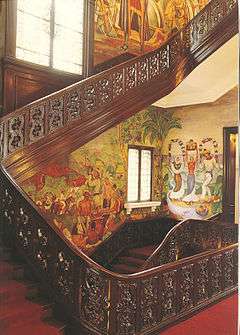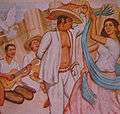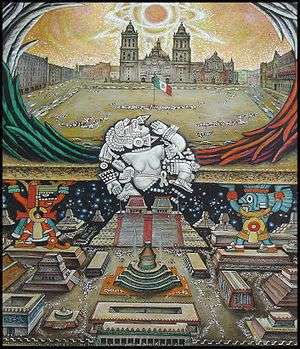Roberto Cueva del Río
| Roberto Cueva del Río | |
|---|---|
 | |
| Born |
Rodolfo Roberto De La Cueva Del Río April 28, 1908 Puebla, Puebla, Mexico |
| Died |
June 24, 1988 (aged 80) Mexico City, Mexico |
| Nationality | Mexican |
| Education | Academy of San Carlos |
| Known for | Painting, Muralist |
| Movement | Mexican Mural Movement, Social Realism & Folklore |
Roberto Cueva del Río (born April 28, 1908 in Puebla City, Mexico as Rodolfo Roberto De La Cueva Del Río) was a Mexican muralist.
When he was 6, he and his family moved to Mexico City where took elementary studies. In 1923 he worked with Ernesto García Cabral in "Excélsior," a newspaper political cartoon shop.
From 1924-1928 he attended Escuela Nacional de Bellas Artes de la Universidad Nacional & Academy of San Carlos. His teachers were Germán Gedovious, Sóstenes Ortega, Raziel Cabildo. The dean Alfonso Pruneda granted a monthly scholarship support ($40), to foment his studies in Fine Arts academy. With this scholarship and his work selling he became a drawing & painting teacher for some Mexican states, teaching in rural schools as a cultural mission.[1]
In 1926 painted his first murals in elementary schools from the Educational Department of Mexico.
In 1928 open his first draws and political-cartoons expo.
In 1930 was suggested for Diego Rivera, Fine Arts Director as the best muralist to be designated for the murals in Mexican embassy in Washington D. C. The governor of the Mexican State of Puebla Leonidas Andrew Almazán supported his talent and promoted this job. Howard S. Phillips, "Mexican Life Magazine" editor sent a note to Anita Brenner, where he extols Cueva's work and thinks is a great opportunity so he can get fame and fortune in United States as many painters does.
In 1930 painted new murals in Cuernavaca Morelos, Mexico, as typical folklore themes.
In 1931, in New York City he was invited to expose his work in Delphic Studios Gallery, owned by Alma Reed. His art got excellent comments from U.S. critics, and got attention from Juan José Tablada.
In 1933 start the Embassy frescos, with the themes: La Fiesta de las Flores y Frutas en Tehuantepec (Flowers and Fruits party in Tehantepec), also called Fiesta Tehuana; Los Volcanes, Fraternidad Panamericana (The volcanoes and Pan-American fraternity). The fresco created great expectations in Mexico. "El Nacional" newspaper published a head note on June 19, 1934 about the visit of the artist back to Mexico. "Now is among us the great Mexican painter Roberto Cueva del Río" with a deeply exaltation, pointing that: "The fresco that he is creating in the embassy will be the biggest worldwide, due the walls around the central stair has a picture continuity and ideological solution from the floor to the ceiling. Cueva del Río makes next to José Clemente Orozco, Diego Rivera and David Alfaro Siqueiros, the quadrangle of the best paintbrush artists with real work outside of Mexico". In this mural we can see Carlos Fuentes in his youth.
1933, working in Palacio de Gobierno un Chilpancingo City, in Guerrero, Mexico.
In 1938 he worked for the President General Lázaro Cárdenas del Río, for Casa Eréndira house, in Pátzcuaro Michoacán México with Michoacan state historic themes; Casa Jililpan for Jijilpan and Páztuaro’s museums. Cerro Colorado City Viewpoint in Pátzcuaro (two frescos with the Pan-American harmony, discovery of America and México-Tenochtitlán foundation).
In 1941 he returned to Mexico and worked in the Michoacans Heroes portraits in the Palacio de Gobierno in Morelia City, Michoacán.

In 1942 he was designated the Fine Arts School principal headmaster, in Morelia City.
In 1944 he decorated the mail congress hall with a mural ”Congreso de Apatzingán.”
In 1945 he was commissioned for personal portraits and created political magazine covers.
In 1952 he made a mural about the Conquest of Mexico, in the Palacio de Gobierno in Chilpancingo City, Guerrero.
In 1955 he made murals in Valle del Mezquital.
In 1956 in the former San Francisco Convent Museum.
In 1957 Guerrero’s Revolution history, in the Palacio de Gobierno in Chilpancingo City, Guerrero.
In 1962 he performed the hall of the ex government palace Murals.
In 1963 Morelos portrait for the Deputies Chamber at Cortes Palace in Cuernavaca, Mor. Mexico
In 1964, he performed two murals with Ayala’s Plan Theme; General Alvarez protest in Cuernavaca. One of the murals was at Casino de la Selva Hotel and the other one at Cuernavaca city hall.
In 1966 He performed a big portrait of Hidalgo Liberator, at the Senate of Mexico City.
In 1967 he made Illustrations about the history of the Mexico Conquest (they were made for a history of Mexico book)
In 1968 five portraits of important Mexican doctors for decorate the psychiatric hospital halls in Mexico City. In the same year imparted watercolor, drawing and composition classes at the Architecture School at University of Mexico. Mural at Government Palace Hall in Acapulco, Gro.
In 1973 He decorates the Acapulco municipal palace, six big murals with the history and customs of the Mexican port.
In 1976 he made a folding screen of 5.00 x 2.00 mts. with the Conquest of Mexico theme, where it is exposed the two cultures encounter and the fusion of the Mexican Indian culture and European races, and the result of these until our days.
In 1980 he travels to Europe and makes several watercolors in Spain, France, Italy and some more places.
In 1985 makes easel painting in watercolor, oil and acrylic in Morelos, Guerrero, Mexico, Puebla States and some other places in Mexico.
A whole life rich of art, he performed murals and easel painting. Painted portraits for politics, presidents of the Mexican republic as well as theirs wives; also governors, industrials, artists, national heroes, cartoons, customs themes, landscapes, portraits and some many more themes. All a life dedicated to pictoric art. Unfortunately much of his work could not been found, it is made a great effort to join the most possible through their collections, also the National University of Mexico, The National Institute of Anthropology and History and the Institute of Fine Arts are very interested in reunite the most of the work for being shown.
He dies in 1988 at the age of 80 years, due to an accident in his house, but he was very sick already by the time.
 Diego Rivera' recommendation.
Diego Rivera' recommendation.- Casa Eréndira.
 Inditos Coloreados.
Inditos Coloreados.- Cuahutémoc en llamas.
 Mural en el Palacio de gobierno in Acapulco, en Guerrero.
Mural en el Palacio de gobierno in Acapulco, en Guerrero. Mural en el Palacio de gobierno in Acapulco, en Guerrero.
Mural en el Palacio de gobierno in Acapulco, en Guerrero. Work in Palacio de Gobierno in Chilpancingo City, Guerrero, Mexico, 1933.
Work in Palacio de Gobierno in Chilpancingo City, Guerrero, Mexico, 1933. Fundacion Tenochtitlan
Fundacion Tenochtitlan